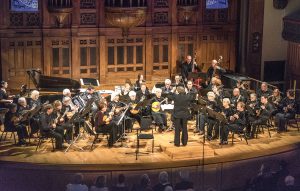Milestone coincides with 125th anniversary of Ukrainian immigration

PHOTO COURTESY TMO: Unlike many mandolin orchestras in other parts of the world, the Toronto Mandolin Orchestra (above) does not include guitars, though it does at times perform with woodwind instruments, percussion, and two accordions.
By Summer Reid
It’s a humble yet versatile instrument that was a bit of a fad in certain parts of Europe around the turn of the last century. But after the mandolin — a lute that has four pairs of strings tuned in a progression of perfect fifths — was brought over the sea by immigrants seeking a new home, it became an indelible part of their ethnic heritage.
So it was with the Ukrainian diaspora in Canada, where the Toronto Mandolin Orchestra (TMO) was founded 60 years ago to preserve traditions that predated it by 65 years. And this month the orchestra is celebrating that milestone with an anniversary concert on Nov. 19 at the Trinity-St. Paul’s Centre featuring popular folk and classical pieces, and special guest soloist Tamara Volskaya.
“For both waves of immigrants, mandolins were the instrument of choice for providing children with a musical education because they were accessible and inexpensive.”
The very first Ukrainian immigrants came to Canada before the First World War. The federal government at the time was determined to settle the western provinces to prevent them from becoming an American territory, and specifically sought out farmers from the Ukraine, which was struggling economically.
“There was a $10 registration fee, but you got a quarter section of land,” explained Maxim Tarnawsky, an associate professor of Ukrainian Studies at the University of Toronto. A second wave of Ukrainian immigrants arrived after the Second World War, but, said Tarnawsky, these people were “by and large intellectuals” escaping Soviet rule, and they chose to settle in Toronto.
For both waves of immigrants, mandolins were the instrument of choice for providing children with a musical education because they were accessible and inexpensive.
Indeed, the Gibson Mandolin-Guitar Manufacturing Co. in Kalamazoo, Mich., had been producing the whole family of mandolins since the turn of century, facilitating the growth in popularity of the instrument, as well as the formation of mandolin orchestras.
As a result, various ethno-cultural associations and clubs incorporated the mandolin, establishing schools for children, and providing individuals from working-class families with the musical training they may not have been able to afford otherwise.
Although there were many orchestras that included the mandolin alongside other stringed instruments, it was not until 1956 that Eugene Dolny, a conductor and the music director of cultural groups of the Association of United Ukrainian-Canadians, established an orchestra dedicated solely to the mandolin: the Toronto Mandolin Orchestra.
The orchestra’s uniqueness extends beyond its focus on the mandolin. It was the first to use the tenor (or octave) mandolin in the string section, and it incorporates the domra, a Ukrainian and Russian version of the mandolin with four strings instead of the usual eight. Further, unlike many mandolin orchestras in other parts of the world, the TMO does not include guitars, though it does at times perform with woodwind instruments, percussion, and two accordions. Finally, Dolny, who had formed a relationship with the world-renowned Osipov Folk Orchestra of Moscow, received many of that orchestra’s original compositions, specifically transcribed for the TMO.
The TMO joined the National Shevchenko Musical Ensemble Guild of Canada (SME) in 1964, and began to accompany the ensemble’s dancers and choir in addition to performing in its own concerts. Together, they have performed across Canada, and toured Ukraine twice, in 1970 and 1989.
“They say that it’s better one time to hear than 10 times to tell,” said TMO’s artistic director Alexander Veprinsky, of the orchestra’s unique sound. He’s been with the group for 21 years, during which time he has arranged almost half of the orchestra’s repertoire. These days the orchestra is made up of musicians from a wide variety of backgrounds, and performs music from all kinds of genres including classical, folk, and popular music, in addition to Russian and Ukrainian music.
The musicians, who become family through performance, tended to stay with the orchestra for a long time.
“Mary Kuzyck, she was the concert mistress of the orchestra from the very beginning, and she was like a mother to me here,” said Ira Erokhina, the orchestra’s concert mistress of Kuzyck, who assumed the position when the TMO was formed. Described as the glue holding the orchestra together, Kuzyck was the TMO’s concert mistress for 56 years, until her death at the age 94.
READ MORE:
ARTS: Library’s ukulele drop-in program leverages diminutive instrument to launch musical journeys (August 2016)
ARTS: Esprit Orchestra goes to China (July 2015)
